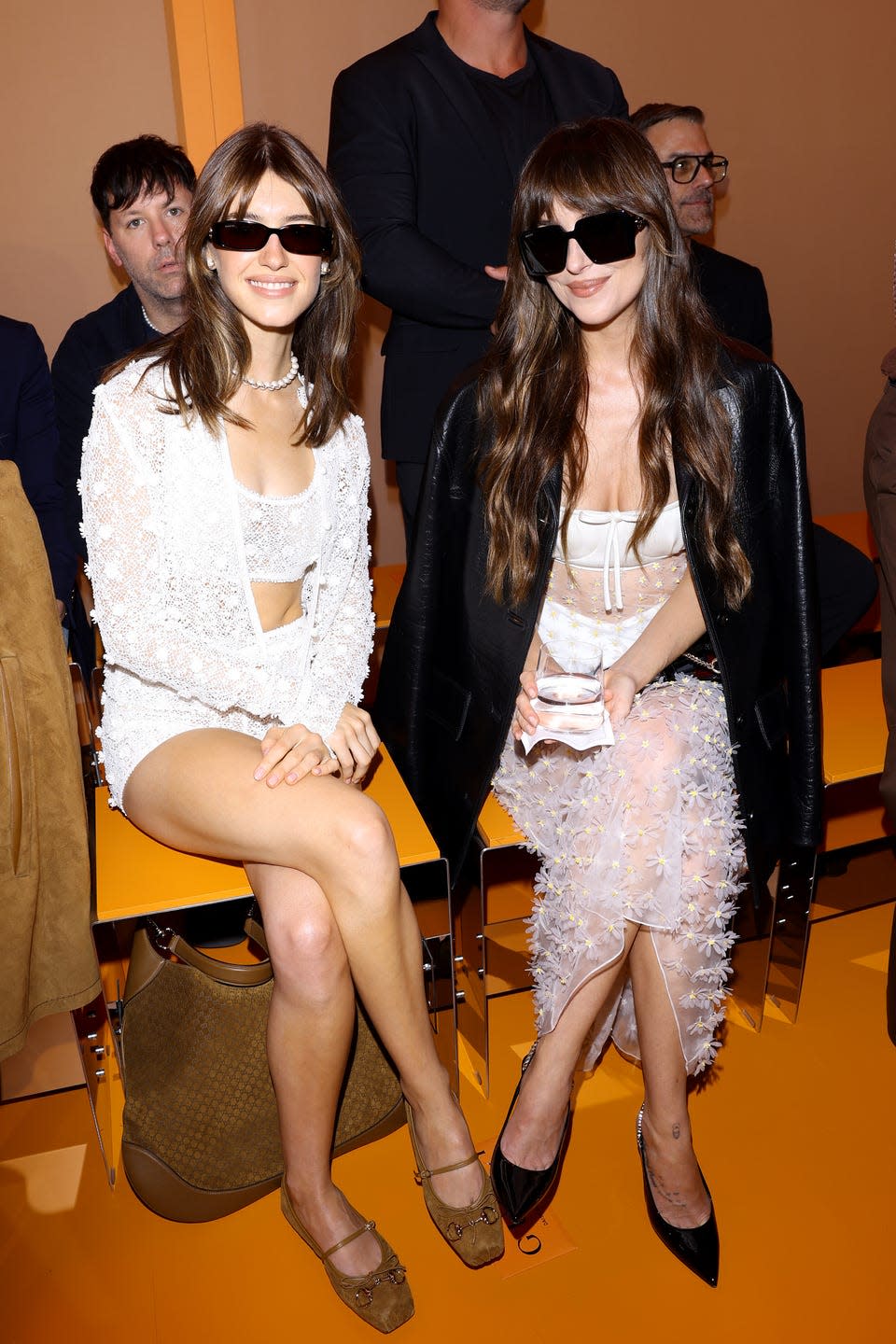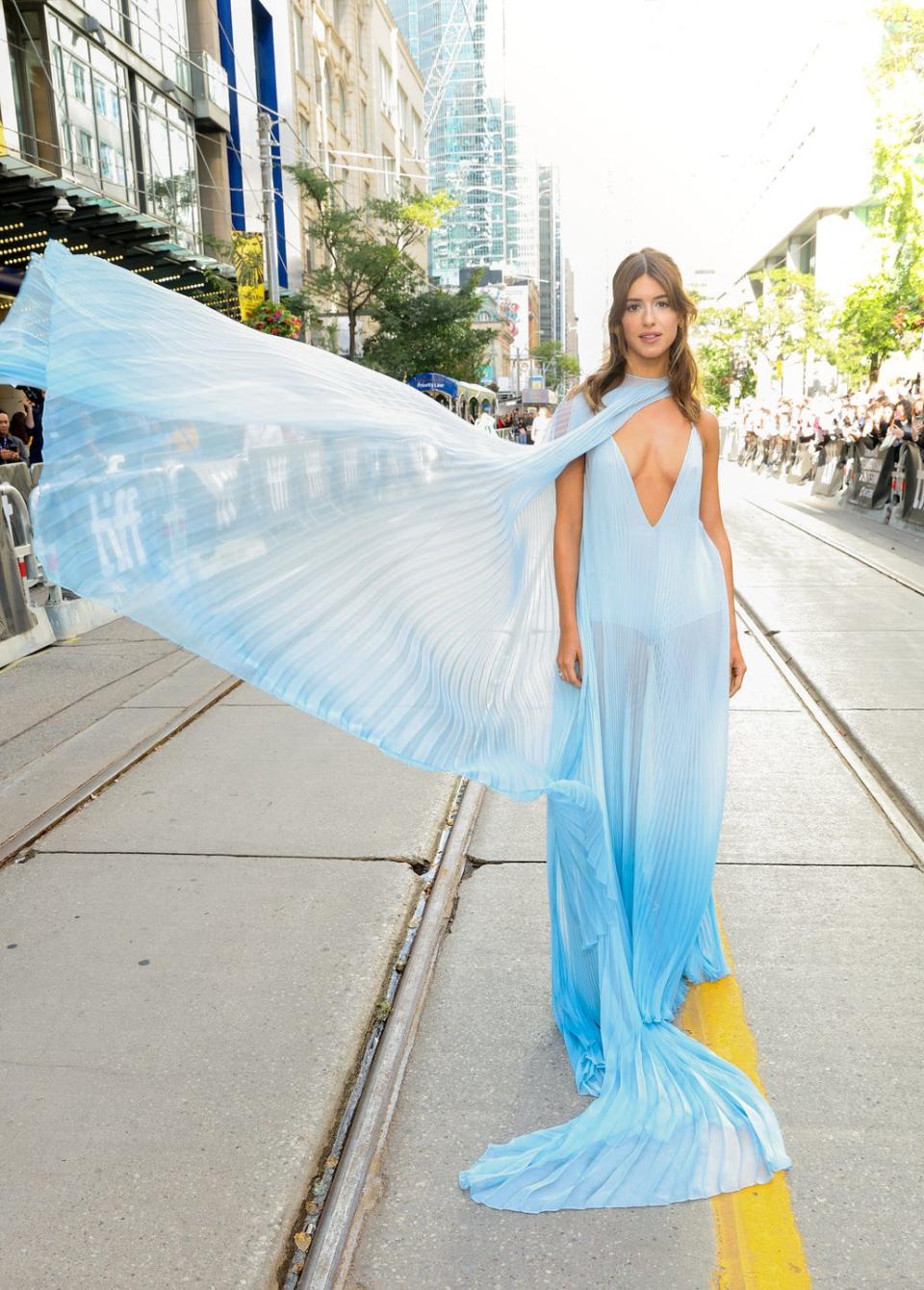Why Is 'Naked Dressing' Deemed 'Cool' For Some And 'Cheap' For Others?

Call it what you want – the sheer-naissance, sheer-volution or even the she-era – but it’s clear (if you’ll excuse the pun) that sheer dresses – or 'naked dresses' – aren’t going anywhere. What was once exclusively the preserve of the young, thin and provocative, has now become so ubiquitous that it’s hard to believe it still causes so much pearl-clutching, condemnation and moralising, with big knickers and visible nips ten a penny on the catwalk or red carpet.
Fashion houses like Saint Laurent, Valentino, Chloé, Gucci and Nina Ricci have made the look their signature, with translucent tulle or fishnet lace offering a peek at the body underneath, while celebrities including Dakota Johnson, Florence Pugh, Kendall Jenner, Daisy Edgar Jones and Rosie Huntington-Whiteley have pledged their allegiance to the 'naked' flag. The trend has even trickled down to the high street, with British stalwart Marks & Spencer now offering its take with a black column skirt featuring an organza panel.
FIND OUT MORE ON ELLE COLLECTIVE

Yet whenever a famous woman is photographed wearing a 'naked dress', among the adoration from sartorial fans like us, there is almost always the same old negative reaction from the wider public. A cursory scroll through the comments on a newspaper article discussing the sheer dress trend is a good litmus test for society’s view on them.
'Tacky and cheap.'
'Attention-seeking… and not the right kind.'
'It’s sexier to leave something to the imagination.'

The misogyny is unsurprising. After all, the decision to wear a sheer dress is a political statement to varying degrees. At the least, it’s an empowering move that is a celebration of the female form. At the most, it’s putting two fingers up to the patriarchy. 'There’s a constant tension between how much of this is about the male gaze and how much of it is about women’s liberation,' shares Dr Serena Dyer, a fashion historian. 'The way in which it is so underpinned by women’s sexuality is really fascinating to me.'
Such was the case for Rose McGowan in 1998, when she wore a fishnet dress and leopard thong to the VMA Awards, a decision she later revealed was a direct result of her alleged abuse at the hands of former Hollywood mogul Harvey Weinstein (he was found guilty in 2020 of raping and assaulting two women and is currently serving 23 years in prison). 'It was my first big public appearance after being sexually assaulted,' she later told Yahoo. 'So it was like at the end of Gladiator when he comes out and he's like, Are you not entertained? And if you look at me, I did it with power. I didn't do it with my hand on my hip to be sexy.'

If history has taught us anything, it’s that the patriarchy does not like women having agency. In fact, similar slut-shaming of women in sheer clothing has been happening since we first swapped our intricate silk gowns for translucent muslin dresses, way back in the Regency period.
As Dr Dyer explains: 'There was a notable rise in newspaper reports of women dying by fire because of their muslin dresses getting caught in fireplaces. At the time, Regency women were doing quite daring things, it was an era of revolution and change. There’s always an uptick in these kinds of stories when women are wearing fashion that men don’t approve of.' Satirical imagery also highlighted how frivolous women’s muslins were considered: 'One famous example is, "Three Graces In A High Wind", which featured very visible nipples, and was clearly poking fun at the fashion.'
It's a topic Pugh has commented on several times in recent years, most notably after she responded to backlash for 'freeing the nipple' at the Valentino’s haute couture show in 2022 in a sheer pink tulle dress. 'I think the scariest thing for me are the instances where people have been upset that I’ve shown "too much" of myself,' she told ELLE UK after first speaking out about the body shaming she faced at the time on Instagram. 'When everything went down with the Valentino pink dress a year ago, my nipples were on display through a piece of fabric, and it really wound people up. It’s the freedom that people are scared of; the fact I’m comfortable and happy. Keeping women down by commenting on their bodies has worked for a very long time.

'I think we’re in this swing now where lots of people are saying, "I don’t give a sh*t." Unfortunately, we’ve become so terrified of the human body that we can’t even look at my two little cute nipples behind fabric in a way that isn’t sexual. We need to keep reminding everybody that there is more than one reason for women’s bodies [to exist].'

Yet amongst those whose sheer dresses have not been heavily condemned there is a shared similarity: none of these women consented to their nudity. Take Jane Birkin, for example, whose sheer knit dress which exposed her breasts under the paparazzi flash at the 1968 premiere of her film Slogan, when she was just 22 years old, has long been seen as evidence of her chicness. Or her latter day sartorial acolyte, Kate Moss, whose iconic silver slip dress – accessorised with black knickers, a cigarette and nothing else – has gone down in the annals of fashion history as a major source of inspiration (the same dress recently sold at auction for hundreds of dollars).

The commonality between both of these historic fashion moments was the women’s lack of agency – both were unaware that their dresses were so exposing, until they were exposed. Not that it bothered either of them. As Birkin jokingly quipped later in life, 'If I had known, I would not have put knickers on!' Similarly nonplussed was Moss, who has nodded to the moment countless times since, reflecting on it 30 years later: 'Never wear a pasty! That’s my advice to the younger generation. They are so prudish nowadays.' The magic reveal, the peek-a-boo moment, is almost part of the myth for both women.

Yet others haven’t been so blasé with being exposed, and understandably so. The late Princess Diana, then Lady Diana Spencer, was caught unawares by a photographer who captured the outline of her legs during an impromptu photoshoot outside the nursery she worked at when she was just 19. Speaking later, the photographer, Arthur Edwards said: 'I didn't do it on purpose, I promise. I didn't do it to embarrass her, but it was such a good picture you couldn't not publish it… Everybody doesn't believe this, but it is the gospel truth — halfway through, the sun came out and revealed those beautiful legs.' Diana, meanwhile, was less than thrilled, reportedly declaring to Prince Charles: 'I don't want to be known as the girlfriend who had no petticoat.'
It’s particularly telling that the women whose sheer dresses are pinned on moodboards and hailed as iconic moments are often the very ones who never intended them to be. As a society, it seems we can handle women’s sexuality in our faces as long as it’s unintentional. We’re the ones choosing to look, rather than being shown, and therein lies the problem.
ELLE Collective is a new community of fashion, beauty and culture lovers. For access to exclusive content, events, inspiring advice from our Editors and industry experts, as well the opportunity to meet designers, thought-leaders and stylists, become a member today HERE.
You Might Also Like


